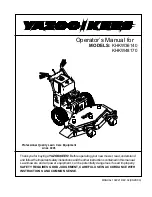
73
H24d
Maintenance Instructions
Adjustments
ADJUSTMENTS
Transmission Control
IMPORTANT:
The proper adjustment of the trans-
mission control stops is
essential
for efficient oper-
ation and life of the transaxle. These stops are
properly ad justed at the factory and should only
require read justment if the transaxle or related
control linkage is removed or changed.
NOTE:
It would not be unusual for a new machine,
after the initial 5 or 10 hours of operation, to begin
to not travel straight (this is due to the break-in of
the tran smissions). To fine tune tracking, refer to
Step 5 - Straight Tracking Adjustment on page
76.
Step 1
- Steering Lever Position Adjustment
NOTE:
For proper operation, the steering levers
should be adjusted to sit evenly using the following
procedure.
1. Examine the steering levers to make sure they
are
parallel front to back
in relation to one
an other. If they are not equal, adjust accord-
ingly. (The handles may or may not be even at
this point.)
NOTE:
The
LH steering lever is non-adjust-
able.
This procedure will require adjustment
of the RH lever to make it even with the LH
lever.
Levers should sit
parallel to each other
Lever Alignment
2. Adjust the position of the RH lever by turning
the stop bolt in the Speed Control Actuator in
or out. Turning the stop bolt in will make the
RH lever move back, and turning it out will
make it move forward. Tighten the locknut.
Stop
Bolt
Stop Bolt Location
Step 2 -
Steering Handle Adjustment
An adjustment range of approximately 3 in. (76
mm) is available on the steering handles—the
handles can be adjusted forward or aft depending
on the arm length of the operator. The handles
can be adjusted by loosening the locknut at the
pivot point and the locknut holding the handle in
position in the adjustment slide. Adjust handles
into most comfortable position and tighten both
locknuts.
Adjustment
Slide
Locknut
(Position)
Locknut
(Pivot Point)
Steering Handle Adjustment












































